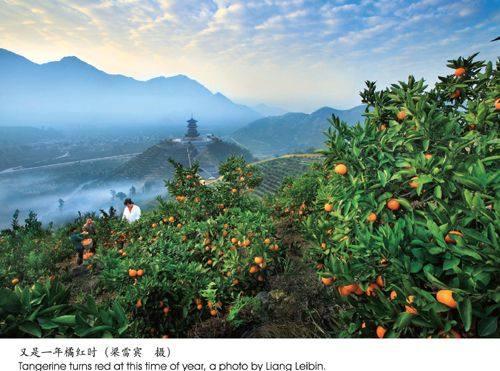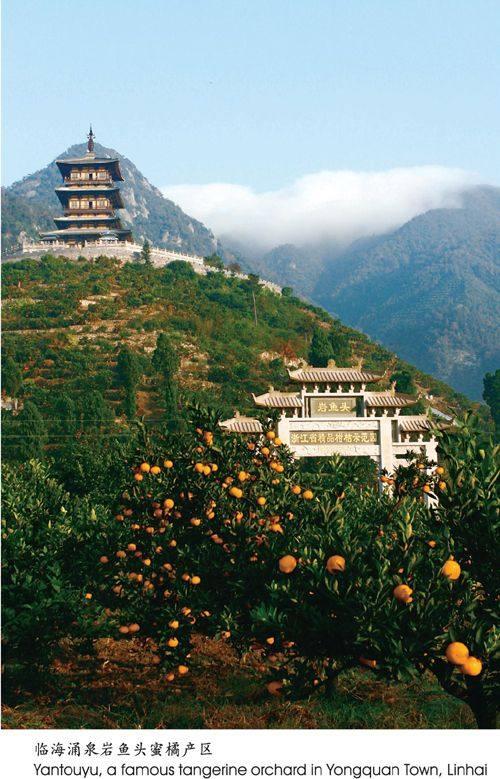临海遍野飘橘香
2012-04-29李建兵
李建兵



第一次知道临海蜜橘的名头,是2009年参加临海江南长城节途中,看到高速公路边的巨幅广告牌—“临海一奇,吃橘带皮”。
作为明长城的师范和蓝本,临海的江南长城海内闻名,可是,天下哪有带皮吃的橘子?
问了台州市经济作物总站的老师之后知道,带皮吃的是临海蜜橘——皮又薄又脆,跟果肉粘连得很结实,剥起来费劲,还不如一口咬下去爽快,既鲜且甜。这橘皮不苦不涩的主要原因是,表面油孢含量比较少。油孢指的是橘皮上的小颗粒,里面有丰富的橘油,苦涩就在它身上。
那么,究竟是怎样一片土地孕育了如此甜美的果实?
其实,与临海紧邻的黄岩,早在古代,就是著名的橘子之乡。黄岩“本地早”的名头,大部分中国人都如雷贯耳。
但是近几年来,临海蜜橘却出人意料地崛起,成为超过普通橘子价格数倍十数倍的极品。
橘子成熟的秋天,临海漫山遍野起伏着绿色,红红果实挂满枝头,到处是一派丰收景象。清清的灵江水倒映蓝蓝的天,让人心旷神怡!
临海产橘最出名的古老小镇是涌泉镇。“中国无核橘之乡”的巨大招牌,似乎把当地人自豪的心态诠释得淋漓尽致。小镇路旁摆满了各种品牌的涌泉橘子,令人目不暇接。村民们与各路商贾讨价还价,叫卖声、笑谈声打破了小镇的宁静。
在涌泉,让我们感慨颇深,橘子品质高了、地方富裕了,从上到下,似乎都沾染着一股“牛气”,村民有一股发自内心的自信。
“这最好的涌泉橘多少一斤?”
“最好的是‘岩鱼头,50元一斤。”
岩鱼头坐落在海水与淡水交会的灵江边。整个柑橘基地在一个小山坡上,这里三面环山,阳光照射极好,土质淡黄,很少受台风的侵袭,气候宜人。
特殊的气候、特殊的土壤、特殊的环境、特殊的种植培育出中国堪称一绝的无核极品橘子。一般的橘子含糖量是8至9度,而岩鱼头的橘子含糖量为13度;甚至连皮都带着甜味;而且岩鱼头的橘子口感很好,嚼起来没有渣。
在橘园基地,我们遇见了基地主人翁老板。翁老板是个爽快热情之人,他向我们一株株介绍橘树,让我们一株株品尝果实。他自豪地说,这方圆300多亩山地上的3000多株橘树,全是他自己的!现在橘子是供不应求,都来不及采摘,一天就能卖十几万元。
每当蜜橘采摘期,除了橘农忙碌外,也多了一帮“外人”乐呵呵地采摘橘子。来自各地的客人纷纷来到橘园品尝、采摘蜜橘,在农园里吃农家菜,顺带着前往兰田十八潭、南苑农庄等地,惬意地休闲。而这样的涌泉,也真正成为了一座集“采、品、购、游、娱”为一体的生态风情小镇。
涌泉镇政府工作人员告诉我,涌泉蜜橘有现在的身价,与一直以来涌泉打“科技、商标”牌分不开。“我们与国内科研院所建立了长期的技术合作关系,引进先进的栽培技术,并邀请日本、韩国等地专家前来指导。”
除了科技之外,商标,也就是品牌,是临海蜜橘成功的最大因素。
1999年,临海人第一次使用“临海蜜橘”这四个字;仅仅过了两年多,“临海蜜橘”证明商标便注册成功。又过了两年,“临海蜜橘”原产地标志也申报成功。
有了商标后,临海对境内的柑橘品牌进行整合,采用“子母商标”的设计,统一打某某牌“临海蜜橘”。既突出“临海蜜橘”母商标的中心地位,又不失各个子品牌的个性,调动个体的积极性。
最值得一提的是,近年来,每年的秋季,临海总是把江南长城节和无核蜜橘节这两大节庆活动,合在一起隆重举办。登上临海的江南长城,望着远方满目的绿色,心中感慨万千。因为推广蜜橘栽种、重视治污、积极打造环保,现在的临海已经越来越成为公认的绿色城市,连续五年被台州市评为生态市建设优秀单位,并先后获得了国家园林城市、国家卫生城市、省级生态市、省级环保模范城市等荣誉称号。我想,临海蜜橘不仅缔造了农产品的传奇、亮出了地方特色名片,还给当地人打开了一扇环保绿色的品牌大门。
(除署名外,本文照片由庄颖昶拍摄)
Linhai City Offers
Honeysweet Tangerine
By Li Jianbing
The first time I became aware of the existence of the honeysweet tangerine of Linhai was 2009. I was on a long-haul bus traveling toward Linhai and I was going to take part in Linhai Great Wall Festival. I spotted a huge advertisement board by the roadside proudly flaunting the honeysweet tangerine: enjoy the wonder tangerine without removing the peel. It is said that the great wall in Linhai served as the prototype of the Great Wall reconstructed in the northern China during the Ming Dynasty (1368-1644) and it is a huge tourist attraction in this part of the country. But what is so great about the seedless and edible-peel tangerine of Linhai?
Huangyan, a close geographical neighbor of Linhai, used to be famed for tangerine production. Honeysweet tangerine of Linhai is something brand new. It sells at an exorbitant price. With the same amount of money for a kilogram of honeysweet tangerine, you could buy about ten or more kilograms of tangerine produced anywhere else.
Yongquan Town is the best-known tangerine producer in Linghai. Local residents proudly call Yongquan the nations tangerine powerhouse, totally ignoring Huangyan and other important tangerine producers. In Yongquan, the best tangerine sells 80 yuan per kilo and vendors rarely bother to bargain. There are a few registered trademarks for the local honeysweet tangerine.
The best tangerine farm in Yongquan is located at Yantouyu, a special farming base at provincial and national level. The name literarily suggests fish on rock and it sounds as if the farm location is out of place, but actually, the farm is sheltered by hills on three sides, forming a powerful windbreaker against typhoons that slam into the area frequently in summer. The large orchard is near where the sea and the river meet. The microclimate is most helpful to tangerine growing. Tangerine produced in Yantouyu has 13 percent of sugar content whereas the sugar content of ordinary tangerines averages at 8% to 9%. That is why local residents have registered Linhai Honeysweet Tangerine as a trademark.
The farm is owned and operated by a man surnamed Weng. It spreads on undulating slopes and measures about 20 hectares. The large orchard has about 3,000 tangerine trees. He sells 100,000-yuan-worth tangerine a day in the harvesting season. We toured the orchard and then went to a village restaurant for lunch. The harvesting season is one of the best times around the year for local village restaurants. People drive from everywhere and they visit orchards in the neighborhood, pick tangerines as a pastime for half a day and then buy what they have just picked, dine and wine at village restaurants, and go home. The tangerine harvesting time is also the peak season of local tourism.
Tangerine is the best success story the local people tell at present. They have inherited the success of the great wall made by ancients and they have made the tangerine all by themselves.
Science and business are the two factors that have helped. In 1999, Linhai succeeded in registering Linhai Honeysweet Tangerine as a trademark. In 2001, it successfully registered Linhai as place of origin for its honeysweet tangerine. Linhai then consolidated its tangerine brands, allowing small brands to use the unifying Linhai Honeysweet Tangerine. The local trade organization is commissioned to manage the trademark. It runs a strict quality assurance system to maintain the excellence of local tangerine. In 2004, 14 producers qualified to use the regional trademark. In 2012, there are altogether 25 qualified producers.
Linhai regularly advertises its honeysweet tangerine on CCTV, the countrys largest television network. In recent years, Linhai has been celebrating its great wall and its honeysweet tangerine together in every autumn. The two festivals are now the gold call cards of the city.
As the city promotes honeysweet tangerine as a pillar of local agriculture, it pays close attention to ecology and goes all out to keep its land green and free of pollution. Linhai City has won quite a few honors for its environment-friendly development drive.
